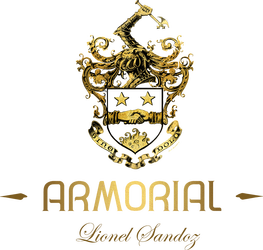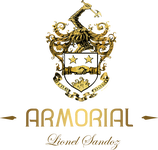DESCRIPTION
BOTET DE LA CAZE
Guyenne
France
Armoiries:
" De sinople, au lion d'or, percé d'une flèche de gueules, au chef d'argent, chargé de trois étoiles d'azur. "
Sources :
- Armorial d'Europe par J.B.Rietstap (Gouda, 1884, Berlin, 1934) (Gouda, 1887, Berlin 1937).
- Armorial général J.B. Rietstap illustré par Victor et Henri Rolland (1903-1926). Colorisé par Lionel Sandoz (1993-2002).
Note: Château de Lacaze (Labastide-Castel-Amouroux).
- Le château a appartenu à la famille Boutet de La Caze (appelée à partir du XVIII siècle, Botet de Lacaze), notables protestants de Casteljaloux.
- François Boutet de La Caze a été lieutenant général du siège de Casteljaloux, charge qu'il avait acheté en 1680.
- À la suite de la révocation de l'Édit de Nantes, François Boutet de Lacaze a été arrêté avec son beau-frère, Augier de Massilos, et tous deux ont été enfermés au Château-Trompette, puis à la Bastille.
- La maison de La Caze a été partiellement démolie, le cimetière des aïeux de la famille profané.
- Leurs biens ont été saisis.
- François Boutet de Lacaze a été libéré plusieurs années plus tard et a retrouvé le château qu'il a restauré où il a mené une vie retirée.
En 1895, l'architecte bordelais Louis Garros a remanié l'aile nord en créant un pavillon abritant une chapelle et a supprimé l'aile sud. En même temps, le paysagiste Eugène Bülher a réaménagé le parc.
Le château a été inscrit monument historique le 27 mars 2008.
Sources:
Wikipédia.
*****
BOTET DE LA CAZE
Guyenne
France
Coat of arms:
" Vert, the lion Or, pierced of an arrow Gules, a chief Argent, charged with three mullets Azure."
Sources:
- Armorial of Europe by J.B. Rietstap (Gouda, 1884, Berlin, 1934) (Gouda, 1887, Berlin 1937).
- Armorial general J.B. Rietstap illustrated by Victor and Henri Rolland (1903-1926). Colorized by Lionel Sandoz (1993-2002).
Note: Château de Lacaze (Labastide-Castel-Amouroux).
- The castle belonged to the Boutet de La Caze family (called from the 18th century, Botet de Lacaze), Protestant notables of Casteljaloux.
- François Boutet de La Caze was lieutenant general of the siege of Casteljaloux, a position he had bought in 1680.
- Following the revocation of the Edict of Nantes, François Boutet de Lacaze was arrested with his brother-in-law, Augier de Massilos, and both were locked up in the Château-Trompette, then in the Bastille.
- The house of La Caze has been partially demolished, the cemetery of the ancestors of the family desecrated.
- Their property was seized.
- François Boutet de Lacaze was released several years later and found the castle he restored where he led a secluded life.
In 1895, the Bordeaux architect Louis Garros redesigned the north wing by creating a pavilion housing a chapel and removed the south wing. At the same time, the landscaper Eugène Bülher redesigned the park.
The castle was listed as a historical monument on March 27, 2008.
Sources:
Wikipedia.
******
BOTET DE LA CAZE
Guyenne
Francia
Escudo de armas:
" En campo de sinople, al león de oro, atravesado por una flecha de gules, un faja de plata cargado con tres estrellas de azur ".
Fuentes:
- Armorial of Europe de J.B. Rietstap (Gouda, 1884, Berlín, 1934) (Gouda, 1887, Berlín 1937).
- General de armas J.B. Rietstap ilustrado por Victor y Henri Rolland (1903-1926). Coloreado por Lionel Sandoz (1993-2002).
Nota: Castillo de Lacaze (Labastide-Castel-Amouroux).
- El castillo perteneció a la familia Boutet de La Caze (llamada desde el siglo XVIII, Botet de Lacaze), notables protestantes de Casteljaloux.
- François Boutet de La Caze era teniente general del sitio de Casteljaloux, cargo que había comprado en 1680.
- Tras la revocación del Edicto de Nantes, François Boutet de Lacaze fue arrestado con su cuñado Augier de Massilos, y ambos fueron encerrados en el Château-Trompette, luego en la Bastilla.
- La casa de La Caze ha sido demolida parcialmente, el cementerio de los antepasados de la familia profanado.
- Su propiedad fue incautada.
- François Boutet de Lacaze fue liberado varios años después y encontró el castillo que restauró donde llevó una vida apartada.
En 1895, el arquitecto burdeos Louis Garros rediseñó el ala norte creando un pabellón que albergaba una capilla y eliminó el ala sur. Al mismo tiempo, el paisajista Eugène Bülher rediseñó el parque.
El castillo fue catalogado como monumento histórico el 27 de marzo de 2008.
Fuentes:
Wikipedia.
SHARE ON SOCIAL NETWORKS
OPINIONS
There are no notes at this time. Be the first to rate!
GIVE A NOTE








